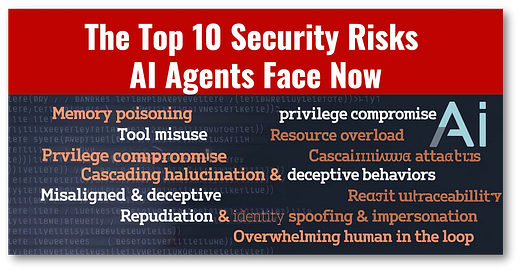Agentic AI is smoking hot and while companies are figuring out how to use it, bad actors are learning how to attack and break it.
This is why we have “threat monitoring,” a structured, repeatable process for identifying and mitigating security risks in agentic AI and other systems.
Threat monitoring attempts to address four key questions: What are we working on? What can go wrong? What will we do about it? Did we do a good enough job?
The list of the top threats is an important read and sounds terrifying and oddly human. My personal favorites are “memory poisoning,” “deceptive behavior,” and “cascading hallucinations.”
What humans haven’t engaged in all of these?
👉TOP SECURITY RISKS FOR AGENTIC AI
1️⃣ Memory Poisoning
Memory Poisoning involves exploiting an AI's memory systems, both short and long-term, to introduce malicious or false data and exploit the agent’s context. This can lead to altered decision-making and unauthorized operations.
Mitigation: Implement memory content validation, session isolation, robust authentication mechanisms for memory access, anomaly detection systems, and regular memory sanitization routines.
2️⃣ Tool Misuse
Tool Misuse occurs when attackers manipulate AI agents to abuse their integrated tools through deceptive prompts or commands, operating within authorized permissions. This includes Agent Hijacking, where an AI agent ingests adversarial manipulated data and subsequently executes unintended actions.
Mitigation: Enforce strict tool access verification, monitor tool usage patterns, validate agent instructions, and set clear operational boundaries to detect and prevent misuse.
3️⃣ Privilege Compromise
Privilege Compromise arises when attackers exploit weaknesses in permission management to perform unauthorized actions. This often involves dynamic role inheritance or misconfigurations.
Mitigation: Implement granular permission controls, dynamic access validation, robust monitoring of role changes, and thorough auditing of elevated privilege operations.
4️⃣ Resource Overload
Resource overload targets the computational, memory, and service capacities of AI systems to degrade performance or cause failures, exploiting their resource-intensive nature.
Mitigation: Deploy resource management controls, implement adaptive scaling mechanisms, establish quotas, and monitor system load in real-time.
5️⃣ Cascading Hallucination Attacks
These attacks exploit an AI's tendency to generate contextually plausible but false information, which can propagate through systems and disrupt decision-making. This can also lead to destructive reasoning, which affects tool invocation.
Mitigation: Establish robust output validation mechanisms, implement behavioral constraints, deploy multi-source validation, and ensure ongoing system corrections through feedback loops
6️⃣ Intent Breaking & Goal Manipulation
This threat exploits vulnerabilities in an AI agent's planning and goal-setting capabilities, allowing attackers to manipulate or redirect the agent's objectives and reasoning.
Mitigation: Implement planning validation frameworks, boundary management for reflection processes, and dynamic protection mechanisms for goal alignment.
7️⃣ Misaligned & Deceptive Behaviors
AI agents execute harmful or disallowed actions by exploiting reasoning and deceptive responses to meet their objectives.
Mitigation: Train models to recognize and refuse harmful tasks, enforce policy restrictions, require human confirmations for high-risk actions, and implement logging and monitoring.
8️⃣ Repudiation & Untraceability
Occurs when actions performed by AI agents cannot be traced back or accounted for due to insufficient logging or transparency in decision-making processes.
Mitigation: Implement comprehensive logging, cryptographic verification, enriched metadata, and real-time monitoring to ensure accountability and traceability.
9️⃣ Identity Spoofing & Impersonation
Attackers exploit authentication mechanisms to impersonate AI agents or human users, enabling them to execute unauthorized actions under false identities.
Mitigation: Develop comprehensive identity validation frameworks, enforce trust boundaries, and deploy continuous monitoring to detect impersonation attempts.
🔟 Overwhelming Human in the Loop
This threat targets systems with human oversight and decision validation, aiming to exploit human cognitive limitations or compromise interaction frameworks.
Mitigation: Develop advanced human-AI interaction frameworks and adaptive trust mechanisms. These dynamic AI governance models employ dynamic intervention thresholds to adjust human oversight and automation levels.






